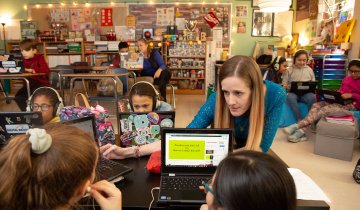“You can eat your broccoli or go to bed,” a common choice many parents have been known to offer their children at mealtime. But is broccoli or bed actually a choice? Will a child given these two options—a cruciferous vegetable or an early bedtime—feel like they are making a decision as an autonomous individual? Or, as Erika Patall, associate professor of education at USC Rossier believes, will they instead feel controlled by an autocratic parent offering this so-called selection?
“Autonomy,” Patall explains, “is one of those experiences that people need in order to thrive. They need to feel like whatever they’re doing is because they want to do it, that it’s consistent with their values, interests or goals, or some internal sense of who they are.”
So, rather than giving a child the option between broccoli or bed, Patall suggests parents might try to reframe the problem and incorporate elements into the choices that their kids like, say, eat a little bit of broccoli and then dessert, eat a little more broccoli, and then a little more dessert.
Or, parents might try another tact altogether; maybe there’s a different vegetable that has similar benefits that the child might like instead. Explaining the benefits of broccoli and how it can help the child achieve their goals (all of those vitamins and minerals can help them stay strong and keep their eyes healthy), might also help the child feel like they are actively making a choice for their own benefit rather being forced to do something they see no value in.
While everyone’s fundamental needs might differ according to their cultural identity or environment, “the reality is that everybody has some version of this need to feel autonomous, as well as feel competent, and connected and related to other people,” Patall explains.
In our everyday lives, it can be difficult to feel autonomous. At an early age, parents are seen as the experts and authority figures that govern our daily lives, but as we begin to go to school choices like broccoli or bed often turn into choices like “take this test or fail.” As we grow up, our employers and government take on this role. The problem with this approach, Patall believes, is that it is not setting us up to thrive.
Creating the autonomy-supportive classroom
In what kind of environment can a student actually learn best? This is the question that is at the heart of Patall’s work on “autonomy support” in the classroom. Patall defines the method in a recent publication as “a personal interaction style in which one person take[s] the perspective of another, considering their thoughts, values and perspectives to guide behavior.” The result, Patall writes, is that students “feel engaged in learning because it reflects their own values, preferences, interests and goals,” which in turn has been found to lead to such benefits as increased motivation and engagement in the classroom, self-regulation in learning, greater academic achievement and increased self-esteem and well-being.
If an educator wants to create an autonomy-supportive classroom, Patall suggests teachers can start by listening to student suggestions, asking students about their backgrounds and home lives, and creating an environment that allows students to contribute their opinions—even if they’re negative.
Things like an overemphasis on testing can hamper student motivation and create negative feelings in students. Engaging directly with these negative feelings in the classroom is essential, Patall believes, even though to some educators it might feel as if acknowledging the negative reactions to another test or another homework assignment detracts and distracts from their agenda.
Patall explains, “it’s important to engage with the negative feelings about whatever is happening in the classroom,” so that students feel like that their feelings are valid and have been heard and considered. After acknowledging the students’ feelings, the next step would be for the educator to engage with the students to come up with reasons why the task they are being asked to do is important to investigate if it’s possible for the educator to create a choice.
And just as important, is also to consider that maybe the students are right—maybe they shouldn’t be doing the task asked of them; maybe it isn’t in their best interest.
Barriers to the autonomy-supportive classroom
It’s one thing to talk about autonomy-supportive classrooms and another to actually implement the practice. In Patall’s experience in working with educators, the most common pushback she gets is that teachers can often feel like this is yet another thing for them to learn and incorporate into an already demanding agenda.
However, Patall urges those with resistance to adapting to this type instruction is that it’s more of a shift in mindset in how a teacher approaches instruction. They don’t need to reinvent the wheel and make everything a choice in the classroom, but if lessons and activities are “100 percent teacher determined,” students are likely to lack motivation. There has to be room, Patall says, for “students to follow their passions.” For Patall, high quality instruction in which there’s a high level of student motivation present in the classroom is simply good instruction.
An important part of the equation for teachers to have the ability to create autonomy-supportive classrooms is a principal who endorses the concept and gives teachers the ability to structure their classrooms in a way that thoughtfully and deliberately considers the perspective of the students. Teachers already have numerous rules and regulations they must follow—from curriculum standards to mandated testing—and if principals create even more rigid polices the teachers themselves are likely to feel controlled.
The ripple effect
One of the goals of the autonomy-supportive classroom is to “encourage students to be their own advocates,” Patall says, and to create a positive feedback loop between the teacher and students so students are truly encouraged to express their ideas, opinions and needs. In turn, teachers consider and incorporate the student perspective into the way they approach instruction.
Students “participate in the process of governing a system,” in the autonomy-supportive classroom, Patall says. And one imagines that if these skills are learned and practiced in the classroom, that this ability to advocate for oneself and to see oneself in the process of governing could also help students learn how to play an active role in democracy later on in life. And while there hasn’t yet been significant research as to how autonomy-supportive classrooms affect how students interact with one another, it has been found to reduce anti-social behavior and bullying in the classroom.
Autonomy support can also help also help address racial and income disparities. Black, Latinx and low-income students, Patall writes, “lack access to highly qualified and credentialed teachers who improve student achievement” and “are disproportionately subjected to mistreatment in the form of teachers’ low expectations of them and harsh, discriminatory, disciplinary action.” When teachers take genuine and sincere steps to attempt to attend to “the psychological needs of students of color and low-income students,” these actions, Patall believes, can help reduce existing disparities and lead to better learning outcomes for these students.





